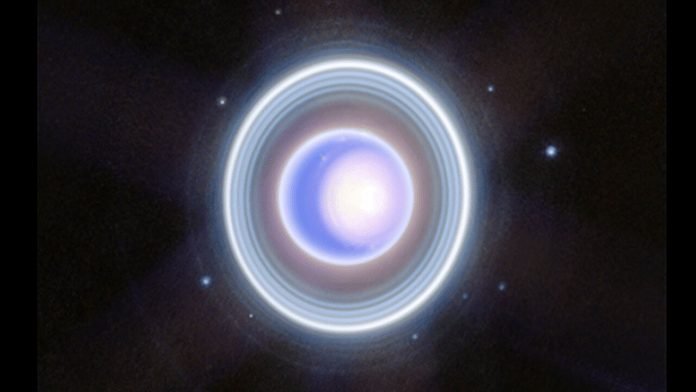
Nearly 50 years ago, NASA’s Voyager 2 spacecraft visited Uranus and discovered a puzzling magnetic mystery.
Unlike most planets, Uranus’s magnetic field is tilted about 60 degrees away from its spin axis, creating an uneven and changing magnetic field.
Understanding why this happens is a major goal of NASA’s proposed flagship mission to study Uranus and its neighboring ice giant, Neptune.
Voyager 2’s findings revealed that Uranus’s magnetic field is not only tilted but also irregular. This strange magnetic field is likely the reason for another unexpected discovery: the planet’s radiation belts are much weaker than predicted.
Radiation belts are areas where charged particles, like protons, are trapped by a planet’s magnetic field. These belts can be quite strong, as seen around planets like Earth.
However, Voyager 2 detected proton radiation belts around Uranus that were about 100 times weaker than expected.
Recently, M. Acevski and colleagues published new research in Geophysical Research Letters to understand why Uranus’s radiation belts are so weak.
They used advanced computer modeling to study the planet’s magnetic field and its effects on charged particles.
Most planetary magnetic fields can be modeled as simple dipole fields, similar to a bar magnet. However, Uranus’s magnetic field is more complex, so the researchers added a quadrupole field to their model to better mimic the planet’s unusual magnetic properties.
Using the Boris algorithm, a tool often used to simulate particle movements in electromagnetic fields, the researchers modeled how charged particles move around Uranus.
They found that as particles travel through the planet’s magnetic field, their speeds change depending on the strength of the field at different points. This effect, caused by the complex quadrupole field, spreads out the particles and decreases their density by up to 20% in some regions.
This spreading out of particles might explain why Voyager 2 detected fewer particles in Uranus’s radiation belts. The spacecraft could have passed through a low-density area, leading to the unexpectedly weak radiation belts it observed.
While this new research helps explain part of the mystery, it doesn’t fully account for the weak radiation belts around Uranus.
More data is needed to understand the mechanisms behind these findings. The proposed flagship mission to Uranus could provide valuable insights and further data, helping scientists unravel the complexities of the planet’s magnetic field and its effects on radiation belts.
Understanding Uranus’s unique magnetic field and weak radiation belts not only solves a decades-old mystery but also enriches our knowledge of the diverse and dynamic nature of planetary magnetic fields in our solar system.



